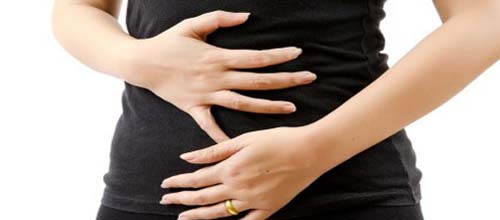
As the main gateway into our body, the gastric system, which includes 26ft (8m) of intestine, is susceptible to a range of problems. All of them share the common symptoms of nausea, stomach pains, vomiting and diarrhoea.
When there is an infection in the stomach, it is known generally as gastro-enteritis. This can range from a mild tummy upset, caused by bacteria in contaminated food, to full-blown dysentery. Similar effects can be produced by poisonous foods, large amounts of alcohol, aspirins, or laxatives.
Bacteria can also cause a sudden flare-up of inflammation of the lining of the intestines. In severe cases the bowel can be perforated and need emergency treatment. When the inflammation is chronic it is called either ulcerative colitis, which affects only the large intestine, or Crohn’s disease, which can affect the whole gut. The cause of both of them is unknown, although various sorts of infection may be involved. Both conditions run in families and are more common among Jewish people and in Western societies. Symptoms include an almost constant urge to go to the toilet, blood in your stools, cramps after eating in the case of Crohn’s, and pain on the left side in the case of colitis. Ulcerative colitis is also associated with skin rashes, arthritis and, in long-term sufferers, cancer.
Crohn’s can affect a person at any age, although the peak periods are adolescence and early adulthood, and after the age of 60. In the young the most common site of inflammation is the ileum (part of the small intestine), which causes spasms of pain in the abdomen, diarrhoea, loss of appetite, anaemia and weight loss. In the elderly, Crohn’s is more commonly found in the rectum and is the cause of rectal bleeding. In both age groups the condition may also affect the anus, resulting in chronic abscesses, deep fissures (cracks) and fistulas (abnormal passageways). It may also attack the colon, causing bloody diarrhoea, and in rare cases the mouth, oesophagus, stomach, and duodenum (the upper part of the small intestine).
The additional distress and discomfort of forming a fistula occurs in about 30 percent of cases. This can be internal (between the loops of the intestine) or external (between the intestine and the skin of the abdomen, or around the anus); often following an operation or the rupture of an abscess, and this may cause leakage of faeces to the skin. Thankfully, abscesses form in only 20 percent of cases.
Further complications to look out for may include inflammation of parts of the eye, severe arthritis, ankylosing spondylitis (inflammation of the spine), and skin disorders.
One of the most common forms of gastric problem is irritable bowel syndrome (I.B.S.), also known as spastic colon. Patients have the usual gastric symptoms – pain, gas, diarrhoea or constipation and indigestion – but it is different from Crohn’s or ulcerative colitis although the cause is also unknown. I.B.S. is a disturbance of involuntary muscle movement in the large intestine, but there is no structural abnormality of the colon so the patient need not experience weight loss or malnourishment. I.B.S. seems to be linked with stress, is more common in women and often starts in early adult life. Some 10-20 percent of adults suffer from I.B.S. and although symptoms may subside and even disappear for periods of time, the syndrome is usually recurrent throughout the patient’s life.
I.B.S. sufferers sometimes find temporary relief from pain on passing a bowel movement or wind, but are often left with a sense that they have been unable to empty the bowels completely. Additional effects may include heartburn, back pain, faintness, a tendency to tire easily, agitation, reduced appetite, and palpitations.
SIGNS AND SYMPTOMS ASSOCIATED WITH GUT IMBALANCES :
Undesirable changes in bowel movements
Signs of malabsorption such as floating, bulky, foul smelling stools
Belching, bloating, indigestion, diarrhoea, constipation, cramping
Blood or mucus in stool, tarry stool, stool colour changes
Anal itching
Halitosis, food allergies and intolerances
Auto-immune illness, immuno-deficiencies
Symptoms of chronic infections
Skin conditions such as acne or eczema
Attention difficulties, hyperactivity, impulsive behaviour
Poor concentration, brain fog, confusion, behavioural changes
Anxiety, depression
Arthritis, joint pain, rheumatoid diseases, osteoarthritis
Asthma, hay fever
PMS symptoms, menstrual problems
Weight gain or loss
Endocrine or neurological imbalances
Fungal infections
Glucose intolerance, slow metabolism, hypoglycaemia
Cholesterol and triglyceride imbalances
Anaemia, vitamin or mineral deficiencies
The intestines have the highest concentration of nerve cells in the body, besides the brain. This Enteric Nervous System (ENS) contains between 70 and 85% of the body’s immune cells. It is a so-called data processing centre, which handles complicated pathways of neurons, neuromodulators and neurotransmitters. There is constant communication between the brain and the gut particularly through nerve cells using serotonin, a neurotransmitter that is also very important for mood regulation. 1000 – 2000 nerve fibres connect both brains and enable the two to talk. When one gets upset, the other one does too.
In the past, many gut diseases were classified as psychosomatic. We now know that this is not the case. There is an element of the brain controlling the gut, but there is also an organic and physiological basis for the functional changes of the little brain.
We treat patients with :
IBS (Irritable Bowel Syndrome)
IBS in relation with Endometriosis and Chronic Pelvic Pain
Crohn’s Disease, Ulcerative Colitis
Diverticulosis, Diverticulitis
Dysbiosis
Candida / Fungal Infections
Pancreatitis
Liver Problems
Leaky Gut Syndrome
